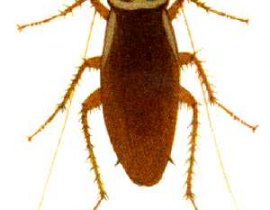Professional Pest Control & Wildlife Management
Australian Cockroach
The Australian roach Periplaneta australasia is similar in appearance to the American roach, but it is slightly smaller.
Inspite of their exotic origins Australian cockroaches are making a home for themselves in the UK, where they can found in most major cities.
For free advice, quotations and surveys please call us on 0800 046 7433 or email us.
-
Risks
Cockroaches are capable of delivering some pretty nasty diseases including; Salmonella, Gastro-enteritis, Amoebic dysentery, Tuberculosis, Tape worm and Hookworms.
-
Treatment
Firstly we must discover the scale of the infestation so as to decide on the best course of action.
To determine how bad an infestation is or if there is one, a thorough survey should be undertaken, searching in cupboards, behind cookers, fridges, under sinks etc. Sticky board insect-monitor traps with pheromone attractants can be a good way to identify numbers and location of harbourages. Entering a room early in the morning (2am’ish )and quickly turning on the lights will often find some scurrying around (worth noting which way they run). Another more professional indicator is to use a flushing agent into crevices and holes etc, This will drive them out and locate their preferred harbourages.
There are two main ways of dealing with cockroaches - spray treatments (including ULV) and baiting them.
Spray treatments use residual insecticides sprayed onto floor/wall junctions, under and around likely harbourages and anywhere the roaches are likely to come into contact with them. In addition to a spray treatment, insecticidal dust can be blown behind cupboards, skirting boards, under work surfaces, into wall voids, behind sockets etc. Insect lacquers also provide a good means of control by forming long lasting barriers around affected areas
Baiting is a more cost effective measure and uses less insecticide around the home or business. Highly palatable baits containing insecticide are placed at many different locations (only tiny amounts are used) focusing on harbourages and affected areas. The baits act quickly, killing any cockroach which feeds upon them. The ingenious part of this treatment is that specially formulated roach baits then make the deceased roach a toxic bait for its cannibalistic friends, with the same bait effectively being consumed by many different cockroaches
We use a micro encapsulated bait which gives the roach enough time to return to its harbourage before succumbing to the active ingredient. This has the effect of essentially placing a bait (the dead roach) exactly where the other roaches are hiding. This creates a domino effect and is a highly effective treatment for these tough to beat creatures
-
Life Cycle
Females lay their oothecae every 10 days, each oothecae (egg case) contains 24 young nymph roaches which should hatch after 44 days. Fortunately, as many as half will fail to hatch.
A normal life cycle will take 6 months to complete.
Cockroaches are vectors for some wonderful diseases including; Salmonella, Gastro-enteritis, Amoebic dysentery, Tuberculosis, Tape worm and Hookworms.
colours are more pronounced. As their name would suggest they enjoy warmer conditions and are unlikely to be found outside here in the UK.
- False Widow Spider Removal
- Cluster Fly help
- The trouble with fleas?
- Mole Catching in Suffolk
- Rats in the Garden
- Wasp Nest Control
- Rats in your chicken Coop
- Anaphylaxis
- Bee Swarms
- Becoming a Beekeeper
- Rare Breed Poultry
- Pest Control with Birds of Prey
- Un-marked vehicles available
- Rabbiting with Ferrets
- Myxomatosis
- Poll-Tex Mesh
- Free Rabbit Control
- Honorary Member Russell Wallis


